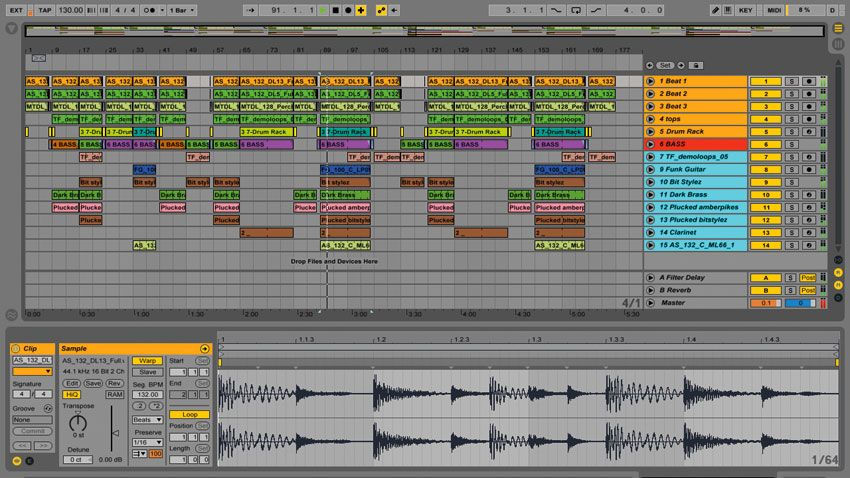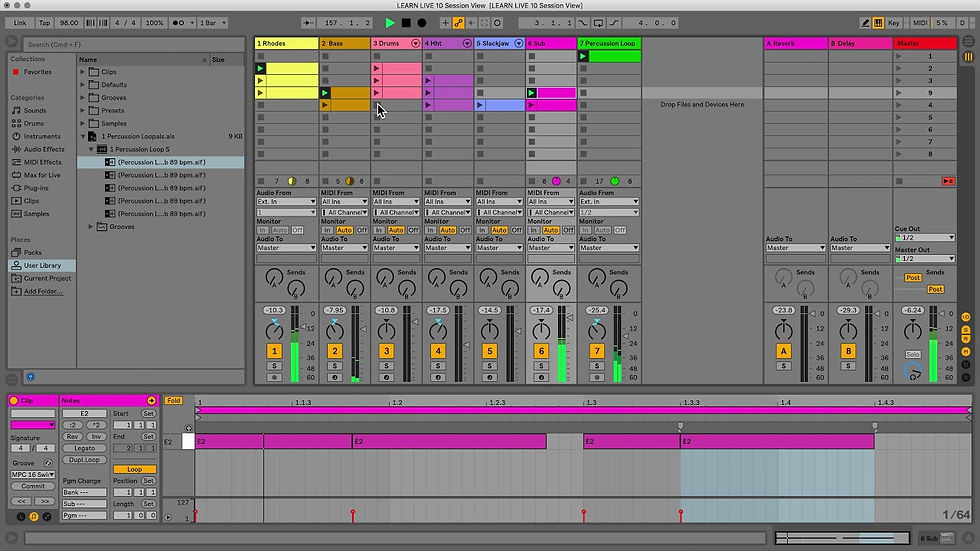

Jul 18, 20245 min read


Oct 31, 20232 min read


Oct 31, 20232 min read


Aug 28, 20232 min read


Aug 25, 20231 min read
Join our newsletter to hear about our blogs and get all the latest news & production tips.











Updated: Mar 9, 2024
When it comes to music production, Ableton Live is one of the most popular Digital Audio Workstations (DAW) available on the market. Most DAWs feature a linear "Arrangement View" display which has more or less become the standard layout for music-making tools since the migration to software.
One of the things that makes Ableton unique is it has two views, Arrangement & Session, which both provide their own unique way of making music. A popular trend I've noticed while educating is that many producers work primarily in the Arrangement View, and they tend to be surprised when they discover the possibilities available inside Session View.
In this article, we will explain both views in detail, as well as their advantages and disadvantages. This should inform you about both views and ultimately help you to decide which one is better suited for your workflow.

Arrangement View
The Arrangement View is a traditional timeline-based interface found within most DAW's that allows users to arrange and edit musical ideas in a linear fashion. This view is ideal for recording and editing live instruments and vocals, arranging complex song structures, and fine-tuning the details of a track. In Arrangement View, users can arrange clips in a horizontal timeline, making it easier to visualize the song's structure.

Advantages of Arrangement View:
Offers a linear workflow that allows users to arrange and edit musical ideas in a traditional timeline
Provides a detailed overview of the song's structure, making it easier to create complex arrangements
Offers advanced editing capabilities such as automation, audio quantization, and audio warping
Ideal for recording and editing live instruments and vocals
Disadvantages of Arrangement View:
Not suitable for live performance and improvisation
Can be overwhelming for new users due to its complex interface
Limited creative capabilities compared to the Session View. Something that a lot of producers struggle with is arranging tracks, which you'd think would be easier to do inside Arrangement View. Though the ability to sketch out rough sections and quickly record a full arrangement in Session View, potentially makes it more appealing for this process.
Session View
On the other hand, Session View is a non-linear workspace that's great for improvising and experimentation. This view is more of a performance-oriented mode that allows you to trigger clips, loops, and other musical elements in real time. You can create different "scenes" by launching groups of clips, allowing you to build up your song in a more free-form manner.

Advantages of Session View:
Easy to use and intuitive interface for live performance and improvisation
Allows users to create and trigger musical ideas on the fly
Ideal for creating loops and patterns for electronic music genres such as techno and house
Offers a non-linear workflow that encourages experimentation and creativity
Disadvantages of Session View:
Limited editing capabilities compared to the Arrangement View
Clips can only be triggered in real-time, making it challenging to create complex arrangements
Lack of a timeline can make it difficult to keep track of the song's structure
Not ideal for recording and editing live instruments and vocals
Hybrid Approach?
While both views serve different purposes and some users tend to prefer one or the other, our recommendation is to consider utilising a hybrid approach instead of just sticking to one. There are a few reasons for this:
Creativity and Inspiration: Session View is great for sketching out ideas and coming up with new sounds on the fly. You can quickly record and manipulate audio and MIDI clips, and experiment with different combinations of loops and samples. Arrangement View, on the other hand, is perfect for refining those ideas and turning them into full-fledged tracks.
Live Performance: Session View is ideal for live performances, as you can launch clips and loops on the fly and create new arrangements in real-time. Arrangement View can also be used for live performance, but it's more suitable for pre-planned sets where you know exactly what you'll be playing.
Efficiency: Using both Session View and Arrangement View can make your workflow more efficient. You can create ideas and experiment with different sounds in Session View, and then drag and drop them into Arrangement View to refine and structure your track.
Conclusion
In conclusion, both Ableton's Session View and Arrangement View have their strengths and the choice between the two ultimately depends on the user's workflow and preferences. If you are looking for a non-linear, creative workflow and want to create musical ideas on the fly, the Session View might be the best option for you. However, if you are looking for a more traditional timeline-based workflow and want to fine-tune the details of your track, the Arrangement View is the way to go.
Though why just limit yourself to one? Try incorporating both views into your workflow to help you work more efficiently & creatively and see how it goes for you. Let us know which one you use and why?
YOU MIGHT ALSO BE INTERESTED IN?
ABLETON TOOLS BUNDLE
Our Ableton Tools bundle is an impressive collection of racks & templates, designed to help you improve your workflow, boost your creativity, & enhance your sounds.

Get notified whenever we post a new guide & get free production tips delivered directly to your inbox.



Comments